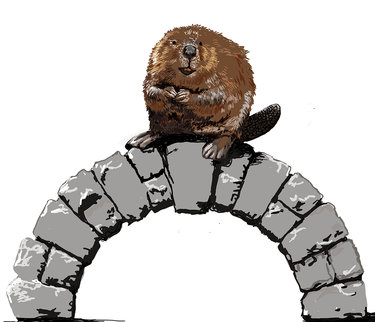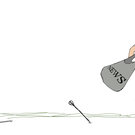How to make a nuisance into an asset
Understanding a problem can lead to a solution.
Take, for example, the beaver dam.
In an era when human hubris is often at odds with the natural environment, we are heartened by an instance in the town of Knox where a solution seems at hand.
The beaver is called a keystone species by the National Park Service. A keystone of course is the wedge-shaped block at the apex of a stone arch, which holds the entire structure in place.
The arch would collapse without its keystone, which is true, too, of a keystone species. The removal of a keystone species contributes to the collapse of an ecosystem.
“Beaver are indispensable creators of conditions that support entire ecological communities,” writes Francis Backhouse in “Once They Were Hats: In Search of the Mighty Beaver,” “and considering the effects of climate change, water stewardship may prove to be the beaver’s greatest gift to humankind.”
Beavers have been called both the “Earth’s kidney” and “ecosystem engineers” as they create new wetlands and ponds by building dams and lodges.
They are known as persistent workers and prolific builders, carrying mud and stones with their fore-paws and timber between their teeth to build and maintain dams. These dams turn small streams into ponds and lakes, providing areas for other animals to thrive.
“To acknowledge that beaver create environments that store water and help sustain other creatures is insufficient,” writes Ben Goldfarb in “Eager: The Surprising Secret Life of Beaver.” “Beaver are nothing less than continent-scale forces of nature and in part responsible for sculpting the land upon which Americans built their communities.”
The largest rodents in North America, weighing between 30 and 65 pounds, the beavers’ ancestors, now extinct, were much larger — the size of a modern-day bear, weighing between 200 and 300 pounds.
Beavers figure prominently in Native American myths and cultures, symbolizing cooperation, persistence, and industriousness. Beavers were also important as a food source for Native American tribes and their fur was used for warmth.
Once Europeans began colonizing the continent, the fur trade between Native Americans and settlers led to a drastic decline in beavers. By the start of the 20th Century, beaver populations in North America had fallen to as few as 100,000, down from estimates of hundreds of millions.
As scientists, and eventually policy-makers and politicians, became aware of the beaver’s importance as well as aware of the value of wetlands, states such as Oregon and New York passed laws to protect beavers.
Beaver ponds store cool water in summer, creating habitat for native fish species, which is important in an era of climate change, with record high summer temperatures and longer periods of low flow. The ponds also store groundwater needed for riverside vegetation, which, in turn, shades rivers and streams, further cooling the water for native fish. In many cases, the stored groundwater also returns to surface flow in downstream reaches, providing important cool water to chill too-warm summer streams.
But, as humans have developed the land, beavers have increasingly been seen as a nuisance. We wrote a story a quarter-century ago when a well-meaning Rensselaerville man ran afoul of state regulations by taking out a beaver dam that had caused water to lap against the home of two sisters in their eighties.
Another human-beaver conflict has presented itself in Knox.
In 2023, the Knox Conservation Advisory Council restored a boardwalk in the town’s 76-acre wetland. The project was completed through the labor of volunteers with a $40,000 grant from the Albany County Soil and Water Conservation District.
The Thursday Naturalists — dedicated nature enthusiasts — produced a list of more than 90 flowering plants, over 100 bird species, dozens of insects, and several land and water animals they observed in the wetlands.
The Knox wetlands have now become a birding hotspot with a place in the Cornell ornithology database.
Knox should be justifiably proud of its boardwalk and wetlands so it stands to reason that residents became distressed when beaver dams threatened the boardwalk on which so many had labored for so long as well as threatening revamped bridges.
In January, the Knox Town Board had a long talk about beavers that Ray Weiler, the park maintenance manager, said were wreaking havoc in the park. He estimated there were 40 to 50 beavers in the park.
Weiler reported that, when he had called the state’s Department of Environmental Conservation, after a hole was ripped in the dam, “you have to jump through hoops to legally remove a dam” and also that trappers have to be licensed.
“What we need is to protect our park,” said Weiler.
The majority of board members agreed. They discussed whether to hire Gary Salisbury to trap the beavers at a cost of $150 for each location and $100 for each animal caught or Lou Saddlemire who would “shoot the big ones” at $15 per hour since “trapping is a bad idea because it’s indiscriminate.”
Councilwoman June Springer said, if a beaver dam goes unchecked, “It becomes a mandatory wetland with unbelievable regulations.”
“As a farmer,” said Councilman Ken Saddlemire, “I’m probably the biggest conservationist out there. I’m not an environmentalist.” He added, “We don’t want to eliminate the beavers; we have to control them.”
Councilman Karl Pritchard said that the area in question at the town park “was a hay field at one time.”
Pritchard indicated that time was of the essence, saying of beavers, “They kick their young out,” which causes more damming upstream and hence more flooded areas.
The board settled on hiring Salisbury for up to $5,000 to trap the beavers.
Supervisor Russell Pokorny, who had described himself as a “tree hugger” during the January board discussion, told The Enterprise this week that Salisbury had trapped just one beaver.
“People followed him and bothered him,” Pokorny said. “It was too unpopular.”
A young woman subsequently came to a Knox board meeting and recommended the town use a “Beaver Deceiver,” Pokorny said.
He then applied for a grant from the county’s soil and water conservation district and announced at the board’s August meeting the grant had been approved. The grant, Pokorny told The Enterprise, includes $500 for investigation and $3,500 each for three Beaver Deceivers.
A Beaver Deceiver, Pokorny explained, lets water flow through a dam without the beavers realizing the dam has been compromised.
The device was invented by Skip Lisle who worked with the Penobscot Indian Nation in Maine in the 1990s. Lisle, who grew up watching beavers in rural Vermont, saw the relatively sterile, manmade pond on his family’s land teem with life as beavers slowly raised the water level, according to his profile on the Beaver Deceivers company website. The beavers re-shaped the topography with dams, canals, and lodges, making the habitat more structurally complex and valuable.
When beavers began clogging the culvert on the town road that runs through his family property, the account goes on, Lisle used some of his father’s old garden fence to create the first crude Beaver Deceiver. For 44 years now, the surrounding wetland ecosystem has gotten steadily larger, richer, and more productive, the account says, adding, “Despite the constant presence of beavers, all road damage and culvert maintenance costs also have been eliminated.”
After getting a master’s degree in wildlife management, Lisle went to work for the Penobscot Indian Nation, which has over 150,000 acres of rural land containing large areas of excellent beaver habitat. There are also hundreds of miles of roads built for the forest-products industry. The Penobscots had a serious problem with clogged culverts where Lisle perfected his invention.
“All the Tribal lands were eventually beaver-proofed without the need to kill any beavers ….,” the account concludes. “This saved an enormous amount of road repair and culvert-cleaning costs, and translated into scores of wetland acres worth hundreds of thousands of dollars in ecological and hydrological services.”
In conclusion, we will return to the place where we started: Understanding a problem can lead to a solution.
So, rather than a short-term fix — beavers typically return after some have been shot or trapped — Knox may now have a long-term solution.
The beaver colony will prosper without damage to human structures and the wetlands will continue to recharge groundwater, maintain biological diversity, produce nutrients, and provide habitat for many creatures — sustaining Knox residents and delighting birdwatchers.


